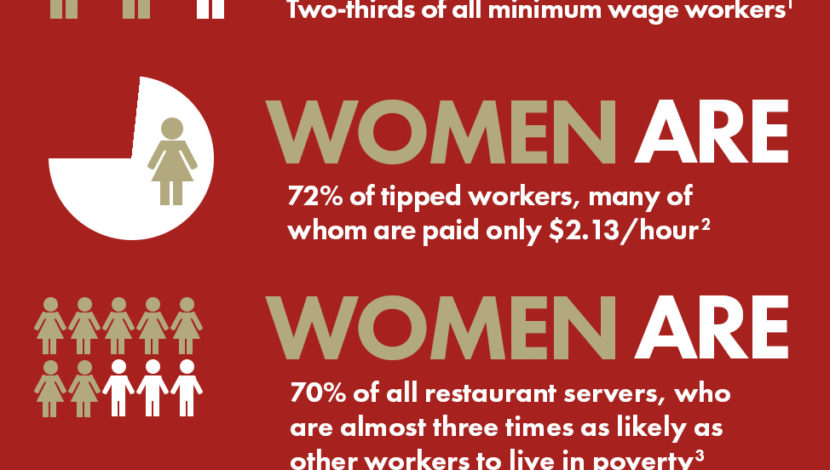The Unitarian Universalist Service Committee advances human rights through grassroots collaborations.
How to Lose $400,000

May 2, 2014
Women, Race, and the Minimum Wage
In today’s low-wage workplaces, women face a double whammy: the insidious effects of the minimum wage plus the gender pay gap. Workers of color face racial discrimination on top of it. Their experience is at the intersection of three oppressive forces: sexism, racism, and classism — three forces that UUSC pays particular attention to in its work challenging injustice. Raising the minimum wage is vital, especially for women workers and women workers of color.
Minimum wage is a poverty wage
Right now, the federal minimum wage is $7.25 per hour. As Kara Smith, UUSC’s senior associate for activism and mobilization, puts it: “Plain and simple: the minimum wage is a poverty wage.” The federal minimum wage adds up to just $15,080 a year for a full-time worker, which is $3,000 below the poverty line for a family of three.
And tipped workers are even more worse off: the federal tipped minimum wage is only $2.13 per hour. While legally restaurants are supposed to make up the difference when a workers’ tips don’t bring their wages up to $7.25, the truth is that monitoring compliance is challenging and 1 in 10 workers report receiving less than the full minimum wage they are due.1
How this plays out:
Workers making minimum wage in this country have to make impossible decisions every day. Pay the electric bill or the phone bill? Buy groceries or medication? Minimum wage means that servers like Claudia, one of the restaurant workers profiled in Saru Jayaraman’s Behind the Kitchen Door, can’t afford to eat; she had to resort to flirting with the cooks for food.
Senator Debbie Stabenow (D-MI) recently spoke on the floor of the Senate: “If you’re going to work for 40 hours a week, you ought to be able to lift your family out of poverty.” The current reality is a cruel irony: many restaurant servers — and minimum wage workers in general — can’t afford to put food on their own tables.
Women bear more of the burden
Poverty-level wages are unacceptable for anyone, no matter their gender. But it’s important to note that women are disproportionately affected by the minimum wage:
That means the statistics about tipped workers’ greater likeliness of living in poverty are referring largely to women. Smith, a 10-year veteran of the restaurant industry herself, puts this in context: “Women are disproportionately affected by minimum wage, are raising children on minimum wage, and are living in poverty. At the same time, women are being squeezed in terms of social programs that are facing huge cuts.”
Senator Elizabeth Warren (D-MA) says it well: “Today the minimum wage isn’t even high enough to keep a fully employed mother and a baby out of poverty. This is fundamentally wrong. Anyone who works full-time should not live in poverty.”
Women of color in the restaurant industry
The Restaurant Opportunities Centers (ROC) United, a UUSC partner, has highlighted how workers of color are disproportionately affected by low wages, particularly in the restaurant industry. They report that 58 percent of workers with incomes below the poverty line and over 50 percent of tipped workers and restaurant workers with incomes below the poverty line are people of color.7
Next time you pull out your wallet to leave your waitress a tip, here is something to consider: “Black female servers are paid only 60 percent of what male servers overall are paid, costing them a deficit of more than $400,000 over a lifetime,” ROC United reports.8
That black female server has done nothing to deserve this deficit. She’s being unjustly punished for her mere existence in our current broken system. To anyone who might argue that if women of color work hard enough then they can move up into positions that pay better: research by ROC United has shown that both women and people of color are denied opportunities to advance in the restaurant industry — so where does that leave many women of color? Under layers of discrimination and the weight of wondering how to make ends meet.
Raising the minimum wage
All of these are true: Minimum wage workers deserve to be paid more. Women deserve to be paid more. People of color deserve to be paid more. All workers, including women workers, deserve the chance to thrive.
Raising the minimum wage is a moral imperative. UUSC is mobilizing its activists to support legislation that would raise the federal minimum wage to $10.10, tie the minimum wage to inflation, and increase the tipped minimum wage to 70 percent of regular minimum wage. The effects of this proposal will be profound if made into law:
- It will raise 900,000 people out of poverty.9
- More than half of all workers who will benefit are women, and more than three-quarters of tipped workers who will benefit are women.10
- The increase will close about five percent of the gender wage gap (which is currently at 23 cents, meaning that women earn 77 cents for every dollar that men earn).11
In the words of feminist labor leader Rose Schneiderman: “What the woman who labors wants is the right to live, not simply exist — the right to life as the rich woman has the right to life, and the sun and music and art. You have nothing that the humblest worker has not a right to have also. The worker must have bread, but she must have roses, too.”
She must have roses. She must — to start, at the very least — have a raise.
1 The White House, The Impact of Raising the Minimum Wage on Women, at 2 (2014), available at http://www.whitehouse.gov/sites/default/files/docs/20140325minimumwageandwomenreportfinal.pdf.
2 Ibid., at 1.
3 Ibid., at 5.
4 National Women’s Law Center, “10 Reasons Raising the Minimum Wage to $10.10 Is a Women’s Issue” (March 2104), accessed April 8, 2014, http://www.nwlc.org/sites/default/files/pdfs/10_reasons_minimumwagefactsheet_march_2014.pdf.
5 The White House, The Impact of Raising the Minimum Wage on Women, at 1 (March 2014), available at http://www.whitehouse.gov/sites/default/files/docs/20140325minimumwageandwomenreportfinal.pdf.
6 Ibid., at 5.
7 Restaurant Opportunities Centers United et al., Realizing the Dream: How the Minimum Wage Impacts Racial Equity in the Restaurant Industry and in America (June 19, 2013), http://rocunited.org/wp-content/uploads/2014/02/report_realizing-the-dream.pdf, 2.
8 Restaurant Opportunities Centers United et al., Tipped Over the Edge: Gender Inequity in the Restaurant Industry (Feb. 13, 2012), http://rocunited.org/wp-content/uploads/2012/02/ROC_GenderInequity_F1-1.pdf, 2.
9 The Congressional Budget Office, The Effects of a Minimum-Wage Increase on Employment and Family Income, at 2 (Feb. 2014), available at http://www.cbo.gov/sites/default/files/cbofiles/attachments/44995-MinimumWage.pdf.
10 The White House, at 11.
11 The White House, at 13.

